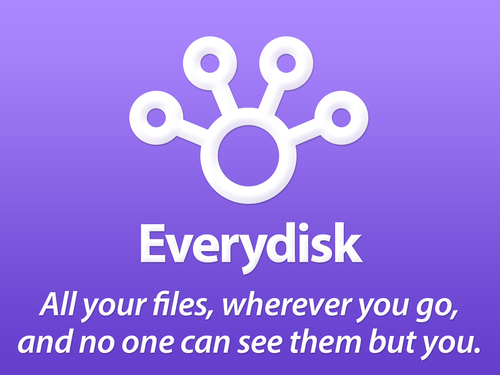Check it out to get a peek at what makes Avatron tick.
A nice interview with Avatron’s intrepid CEO Dave Howell was published in the July 2014 edition of EE Times.
Check it out to get a peek at what makes Avatron tick.
A nice interview with Avatron’s intrepid CEO Dave Howell was published in the July 2014 edition of EE Times.
Check it out to get a peek at what makes Avatron tick.
It’s hard to go wrong with Air Display—the low price, intuitive interface, and wide range of compatibility make it appealing to a wide audience.”

Thanks, Kickstarter supporters! Our Everydisk project has reached 50% of its goal. But we only have 10 days left in the campaign, so if you know anybody who might be interested in backing the development of direct, secure, easy-to-use access to remote files, please send them a link to Everydisk. (Currently, we have everydisk.com pointing to the Kickstarter page.)
10 days: the tension is palpable here. It took us 20 days to get to 50%, so we need to double the pace to reach 100% in 10 more days. But with your help, we can do it!
London-based Middlesex University has put together an infographic guide to some of their favorite (sorry, “favourite”) tools for small businesses.
It’s a good guide. We use several of these tools here. (Including MailChimp, QuickBooks, Zendesk, and of course Air Sharing. Especially Air Sharing.)

SHIPPING!
On October 18, we launched Air Display 2 for iOS. We’ve been working on this new edition for a long time, and we’re delighted to have finished it.
MORE MONITORS

Air Display 2 lets you use a number of iPads as extra monitors for your computer. You can mirror your main display onto these extra monitors or you can extend your desktop to get more screen real estate. So far, our Mac video drivers support up to four devices, while the Windows drivers support only one. But we’re working on the multiple-client support in Windows now. Watch this space! (Subscribe to our Twitter feed if you want to be notified when we get the multi-client support in the Windows drivers.)
NEW DESIGN
We’ve also completely redesigned the workflow in the computer host. The old interface was a sort of generic text-based menu. The new design is interactive and much more intuitive.
SMOOTH UPDATES
Maybe the most significant change in Air Display 2 is optimization. We’ve done a lot with OpenGL rendering to speed up rendering. We’re employing the CPU and GPU in parallel to get all of the performance we can out of the mobile device’s hardware.
(Geek Alert!) We’re stunned by the performance of Apple’s new A7 processor. The A7 features 64-bit processing and OpenGL ES 3. Until now, OpenGL ES 3 has been available only on the iPhone 5s. But in two days, the iPad Air and the iPad mini with Retina display will ship, sporting speedy new A7 processors and OpenGL ES 3. For Air Display, the primary new feature is OpenGL’s “tile-based deferred rendering.” This rendering optimization allows Air Display to render the screen much more efficiently. The result is beautifully smooth updates that let you forget that your second (or third) monitor is on a wireless iOS screen.
NEW APP
We decided to release Air Display 2 as a new app, rather than a free update to the existing Air Display app, for a number of reasons. A big one was that we needed to drop support for the first-generation iPad. Recent builds of Apple’s Xcode app development tool have made it very difficult to support both iOS 7 and iOS 5 in a single app. And since Apple dropped iPad 1 support in iOS 6 in September 2012, we needed to create a new app to take advantage of iOS 7’s awesomeness without forcing our engineers perform feats of intellectual contortion.
Releasing Air Display 2 as a shiny new app lets us concentrate on building for the future without having to break existing users. If you already purchased Air Display 1, it will remain available for download in the App Store, while only Air Display 2 is available for new purchases.
We hope you love Air Display 2 for iOS! If you do, please consider leaving a user review in the App Store.
GREAT NEWS: Air Display’s Windows 8 support is no longer in beta.
As of version 1.8.7, the Air Display drivers for Windows includes our patent-pending accelerated video driver. This means Air Display now supports Aero and Direct X, and is GPU-accelerated for screaming performance and high-quality visual effects.
The new driver is active on both Windows 7 and Windows 8.
OBTUSE TECHNICAL DETAILS
Let’s introduce some concepts here:
XPDM Mirror Drivers: This is the Windows XP Driver Model. The regular install of Air Display Connect for Windows implements a mirror driver. This is how most virtual-display products extend your desktop. One advantage of these is that they work on Windows XP, which still sports a large installed base in the Windows world.
WDDM Drivers: Modern Windows video drivers use the Windows Display Driver Model, which was introduced in Windows Vista. These drivers talk directly with the video hardware to use the GPU for special effects.
WDDM Filter Drivers: Some other products implement “WDDM filter drivers.” Filter drivers fools a real WDDM driver into thinking that a hardware video display is connected to a video card’s secondary video output, and then redirect the pixels to the virtual frame buffer. These drivers offer some of the benefits of real WDDM drivers—they do support Aero and Direct X—but they come with some serious limitations, which is why we didn’t go this route. For example:
Virtual WDDM Drivers: The new beta Air Display Connect implements real WDDM Drivers, using patent-pending virtualization methods. None of those limitations of WDDM filter drivers apply to Air Display’s new accelerated drivers.